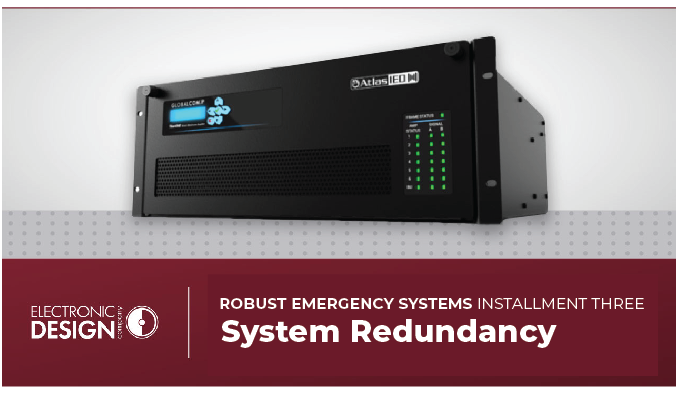
Robust Emergency Systems Installment Three: System Redundancy
January 12, 2022Anyone who has ever had a flat tire knows it’s always a good thing to have a spare. If your picnic gets rained out it’s always good to have a backup plan. The same philosophy applies to emergency notification. When a critical system such as paging, which is what we will focus on here, has a major component that fails it directly impacts the safety of everyone intended to be notified. You need a backup to ensure that any message still reaches the intended audience. There are certain levels of redundancy emergency notification systems can have depending on how robust the system needs to be.
The heart of any modern emergency notification system will be a processor of some kind. In the case of paging or public address systems it will be an audio digital signal processor (DSP). Many current DSP’s are quite literally a computer, often imbedded with a specific operating system, installed within a chassis that have ins and outs to interface with the rest of the world. Although not always a requirement, most of the time they are connected to other sub devices over a network. In this way they can communicate to amplifiers and logic modules while continuously monitoring their status. Several manufacturers offer a redundant DSP (sometimes called a “lifeline”). The main and redundant DSP’s will constantly communicate with each other to verify that they are online and functioning properly. If the main DSP fails, the redundant DSP will pick up routing and processing audio and control signals through the network with essentially no discernable down time. As these processors are the heart of the whole system it is common practice to locate the main and redundant units in separate locations in case one of those rooms is compromised.
Another critical example of devices for a paging system are the amplifiers that drive the speakers. If an amplifier goes down and it supports an area where you can only hear speakers attached to that amplifier, then you have a real problem. Manufacturers that specialize in critical systems will offer amplifiers cards within a larger frame that provide built in backup channels which automatically switch over when another amplifier card fails. As amplifiers are subject to the most functional stress these are the devices which fail most often. Having spare amplifier cards on hand is an easy way to constantly maintain the integrity of the system. A few outboard speaker circuit switching devices are available which allow the use of standard amplifiers that do not have built in backup to be used. Although with greater cost, complexity, and valuable rack space.
Having these backup devices is all well and good but if the power goes out, they all go down, you won’t hear a thing. Many large facilities that require critical paging (think airports, hospitals, etc.) have their own backup power. This can be generators on site or an Uninterruptible Power Supply (UPS). If it is just a generator then there may be a significant delay between the time the lights go out, the generators start up, and then the lights come back on. If a DSP must reboot after power up there can be even more delay. How often do we stare at our computer screens watching a whirligig spin around on startup? Same thing here. And since other paging devices connected to the network are processor based, they can have a reboot time as well. If the facility, has its own UPS that stays on even when the power doesn’t, and your system is connected to that you are good to go. If not, some thought needs to go in to providing a dedicated UPS for the paging system.
Even with all these devices having redundancy and ready to cut over in case of a failure there are still a few things to keep in mind. As all these devices are only as good as the network infrastructure that supports them. If the network fails, then so does the communication between system devices. This can be overcome by providing even more redundancy to the network or even providing a self-contained network for the paging system. The other thing to bear in mind is that not all links can be redundant. For example, control signals from a fire alarm to the DSP are typically just a single connection each. The same goes for the actual speaker circuit. Even so, by using redundancy, you can maintain a robust system that keeps devices going at even the most critical times.


